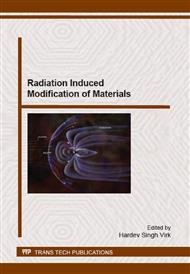[1]
Ho Pui Yee Joan, Ph.D. Thesis, Plasma Surface Modification of Biomedical Polymers and Metals, City University of Hong Kong, Hong Kong (2007).
Google Scholar
[2]
Cao Qin, Ph.D. Thesis, Synthesis of Organic Layer-Coated Metal Nanoparticles in a Dual- Plasma Process, Department of Chemical Engineering, McGill University, Montréal, Canada, (2007).
Google Scholar
[3]
Daniel J.V. Pulsipher, Ph.D. Thesis, Investigating plasma modifications and gas-surface reactions of TiO2 based materials for photoconversion, Colorado State University, Fort Collins, Colorado, U.S. A (2012).
Google Scholar
[4]
R. K. Marcus and J. A. C. Broekaert, Glow Discharge Plasmas in Analytical Spectroscopy, John Wiley & Sons (2003).
Google Scholar
[5]
R.G. Wilson and G.R. Brewer, Ion Beam with Applications to Ion Implantation, John Willy and Sons, New York (1973).
Google Scholar
[6]
I.G. Brown, in: The Physics and Technology of Ion Sources, I. G. Brown (Ed. ), John Wiley, New York (2004).
Google Scholar
[7]
B.H. Wolf, Handbook of Ion Sources, CRC press, Boca Raton, New York (1995).
Google Scholar
[8]
R. Geller, Electron Cyclotron Resonance Ion Sources and ECR Plasmas, IOP, Bristol (1996).
Google Scholar
[9]
H. Conrads and M. Schmidt, Plasma generation and Plasma Sources, Plasma Sources Sci. Technol. 9 (2000) 441-454.
DOI: 10.1088/0963-0252/9/4/301
Google Scholar
[10]
M. W. Thompson, The contribution of collision cascades to sputtering and radiation damage, Phil. Trans. R. Soc. Lond. A 362 (2004) 5-28.
Google Scholar
[11]
F. Aumayr and HP. Winter, Potential sputtering, Phil. Trans. of the R. Soc., Lond. A 362 (2004) 77 -102.
Google Scholar
[12]
M.M. Abdelrahman, Study of plasma and ion beam sputtering processes, in: Horizons in World Physics, Vol. 279, (Ed. ) Albert Reimer, Nova Science Publishers, U.S. A (2012).
Google Scholar
[13]
M.C. Kim, S.H. Yang, J. -H. Boo, J.G. Han, Surface treatment of metals using an atmospheric pressure plasma jet and their surface characteristics, Surface and Coatings Technology 174 –175 (2003) 839–844.
DOI: 10.1016/s0257-8972(03)00560-7
Google Scholar
[14]
Z. Zhang, Ph.D. Thesis, Surface Modification by Plasma Polymerization and Application of Plasma Polymers as Biomaterials, Chemistry and Pharmacy Department, Johannes Gutenberg University, Mainz, Germany (2003).
Google Scholar
[15]
V. Konduru, M. Sc. Thesis, Static and Dynamic Contact Angle Measurement on Rough Surfaces Using Sessile Drop Profile Analysis with Application to Water Management in Low Temperature Fuel Cells , Mechanical Engineering, Michigan Technological University, U.S. A, (2010).
DOI: 10.37099/mtu.dc.etds/376
Google Scholar
[16]
H. Kamusewitz, W. Possart, Wetting and scanning force microscopy on rough polymer surfaces: Wenzel's roughness factor and the thermodynamic contact angle, Appl. Phys. A: Material Science & Processing, 76(6) (2003) 899-902.
DOI: 10.1007/s00339-002-1972-9
Google Scholar
[17]
A.A. El-Saftawy, S.A. Abd El Aal, Z.M. Badawy, B.A. Soliman, Investigating Wettability and Optical Properties of PADC Polymer Irradiated by Low Energy Ar Ions , Surface and Coating Technology Surface 253 (2014) 249-254.
DOI: 10.1016/j.surfcoat.2014.05.048
Google Scholar
[18]
K. Ahmed, Ph.D. Thesis, Design and Experimental Investigations of Electrical Breakdown in a Plasma Jet Device and Applications, Faculty of Engineering at Shoubra, Benha University, Electrical Engineering Department, Cairo, Egypt (2014).
DOI: 10.15676/ijeei.2012.4.2.10
Google Scholar
[19]
W. Zhou, Z.L. Wang, Scanning Microscopy for Nanotechnology, Springer Science Business Media, LLC, 233 Spring Street, New York, NY 10013, USA (2006).
Google Scholar


